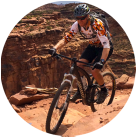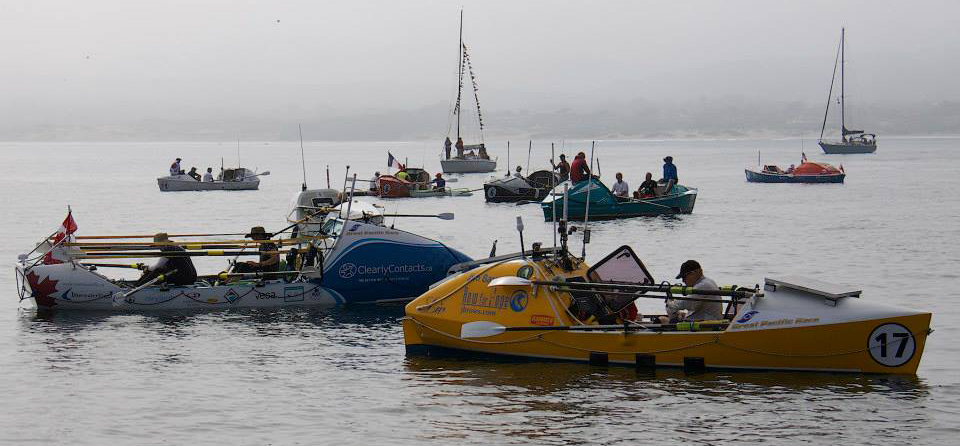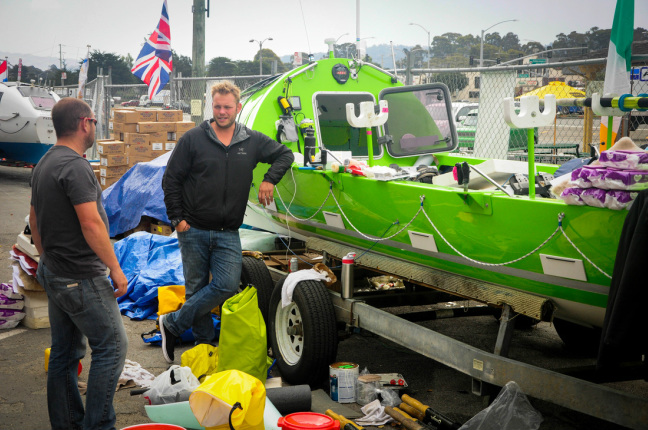Jordan Holsinger is our Scientific Manager and also manages the ASC microplastics project. He recently traveled to Monterey, California, to meet the participants of the Great Pacific Race, the first rowing race across the Pacific Ocean, and train them to collect samples for our microplastics project. Read more about Jordan on our staff page.
Racers prepare for the start of the race, including Jim Bauer, whose boat (No. 17) sports the ASC logo. (Photo by GPR)
Two thousand, four hundred miles. Up to three months on the ocean. Alone. For most this sounds like a nightmare, but for the 34 adventurers setting out on the inaugural Great Pacific Race this is literally a dream come true.
If rowing across an ocean is a major athletic and endurance feat, racing it must border on madness. Fewer people have rowed from California to Hawaii than have been in space.
Earlier this month, the aptly described “biggest, baddest human endurance challenge on the planet” kicked off in Monterey, California, sending 13 boats on what Time Magazine has called “The worst way to get to Hawaii ever.”
Propelled only by their muscles and strength of will, the racers will trace a massive transect across the Pacific collecting samples for our microplastics project.
Elsa Hammond, the first adventurer to contact ASC about collecting data during the race, starts in Monterey. Elsa is one of two female solos and expects to spend three months rowing the Pacific. (Video by Great Pacific Race)
As an official ASC partner, the Great Pacific Race is requiring each boat to collect ocean water samples at designated locations spanning the 35 degrees of latitude that separate Monterey and Honolulu.
While many race entrants are committed to causes beyond themselves, the microplastics project ties all the crews together. During the course of the race – expected to take anywhere from 30 to 90 days – the crews will work together to create the largest human-powered microplastics sampling transect ever completed. This information will be used to fill in missing gaps about the state of plastic pollution in the open ocean.
While many race entrants are committed to causes beyond themselves, the microplastics project ties all the crews together. During the course of the race – expected to take anywhere from 30 to 90 days – the crews will work together to create the largest human-powered microplastics sampling transect ever completed. This information will be used to fill in missing gaps about the state of plastic pollution in the open ocean.
Pacific Warriors Skipper Duncan Tebb and teammate John Wagner strategize on fitting everything into their boat “Limited Intelligence.” The only mixed four in the race, they only met when forming the team. (Photo by Jordan Holsinger)
Preparation is key to a successful ocean crossing. Most impressive, beyond the months of intense training, is the incredible amount of stuff – gear, food, water and people – that teams need to fit in such tiny boats. Space is a hot commodity in an ocean rowboat, especially for the fours who have to fit food, water and emergency supplies for four adults in a space considerably smaller than a station wagon. Each item is carefully packed (or forcefully jammed) into its own place with a lot of discussion about which non-required items to bring and which to leave.
Admittedly, the microplastics sample bottles and supplies don’t take up much room, nor does the protocol take much time. But when you’re stuffed into a tiny boat and rowing 12 or more hours each day, every bit of space and time counts. Yet every crew was excited to grab their sampling packets and rush off to their boats to stow them wherever they could find room. Many volunteered to collect more than their required two samples, hoping to provide even more valuable information in the fight to protect our oceans.
Admittedly, the microplastics sample bottles and supplies don’t take up much room, nor does the protocol take much time. But when you’re stuffed into a tiny boat and rowing 12 or more hours each day, every bit of space and time counts. Yet every crew was excited to grab their sampling packets and rush off to their boats to stow them wherever they could find room. Many volunteered to collect more than their required two samples, hoping to provide even more valuable information in the fight to protect our oceans.
The race officially started last week, sending this contingent of adventure scientists out on the high seas. Now comes the hard part. For the crews it means sore backs, sunburns and rough water while they row across the Pacific. For us, it means patiently waiting for the samples to come back for analysis. However, we can all rest assured knowing our efforts are well worth it.
Visit our Great Pacific Race page for more information about the race, the crews and our microplastics project. Find more about this project and apply for a crew position on the Landmark page. Learn more about ASC projects on ourblog, and by following us on Facebook, Twitter, Instagram and Google+.
Visit our Great Pacific Race page for more information about the race, the crews and our microplastics project. Find more about this project and apply for a crew position on the Landmark page. Learn more about ASC projects on ourblog, and by following us on Facebook, Twitter, Instagram and Google+.



